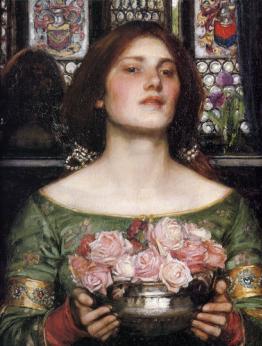
Nymphs finding the head of Orpheus:
a sketch of the nymph at the left


.jpg)

a sketch of the nymph at the left
"This evocative oil sketch was painted as Waterhouse prepared his great 'Nymphs Finding the head of Orpheus' (private collection), signed in 1900 and exhibited at the Royal Academy of Arts the following year.
The depiction of this mythic moment is unique within Victorian painting, and possibly within all of British art. Through the late 19th Century, Symbolist artists and writers had grown evermore enthusiastic about Orpheus, the greatest poet and musician in Greek myth, because he, like so many creative individuals, sang the truth and thus aroused resentment. Dismissed by his contemporaries as effeminate for mourning his wife too passionately, Orpheus was torn to pieces by Maenads after rejecting their advances. Into the river they hurled his head, which demonstrated art's immortality by continuing to sing as it floated away.
Victorian artists usually showed Orpheus singing while still alive, or rescuing his wife Eurydice from Hades. Most avoided the gruesomeness of Orpheus's demise, which instead attracted such Continental peers as the Frenchman Gustave Moreau. Indeed, Waterhouse may have been inspired by Moreau's pensive 'Thracian Girl Carrying the Head of Orpheus on his Lyre' (1866), which the Englishman surely saw on visits to the popular Musée Luxembourg in Paris. Waterhouse was also probably familiar with the recent revival of Orphism, the ancient ecstatic cult that had celebrated Orpheus as a martyr before it was absorbed by the early Christian church.
The depiction of this mythic moment is unique within Victorian painting, and possibly within all of British art. Through the late 19th Century, Symbolist artists and writers had grown evermore enthusiastic about Orpheus, the greatest poet and musician in Greek myth, because he, like so many creative individuals, sang the truth and thus aroused resentment. Dismissed by his contemporaries as effeminate for mourning his wife too passionately, Orpheus was torn to pieces by Maenads after rejecting their advances. Into the river they hurled his head, which demonstrated art's immortality by continuing to sing as it floated away.
Victorian artists usually showed Orpheus singing while still alive, or rescuing his wife Eurydice from Hades. Most avoided the gruesomeness of Orpheus's demise, which instead attracted such Continental peers as the Frenchman Gustave Moreau. Indeed, Waterhouse may have been inspired by Moreau's pensive 'Thracian Girl Carrying the Head of Orpheus on his Lyre' (1866), which the Englishman surely saw on visits to the popular Musée Luxembourg in Paris. Waterhouse was also probably familiar with the recent revival of Orphism, the ancient ecstatic cult that had celebrated Orpheus as a martyr before it was absorbed by the early Christian church.

Gustave Moreau
Orpheus, 1865
Orpheus, 1865
Waterhouse had long been fascinated with the violent aspects of ancient myth. Yet rather than presenting a physically dynamic struggle (such as 'Ulysses and the Sirens' of 1891), he imagined 'Nymphs Finding the Head of Orpheus' as a scene of contemplation subtly laced with horror. Orpheus's severed head constitutes the key feature, yet viewers notice the beautiful nymphs first and last, and are drawn inexorably into the picture by their compassionate gazes and gestures. A now-unlocated drawing of the nymphs (published in 1917) reveals that Waterhouse considered-and wisely rejected-more horrified facial expressions and body language. Instead, he created a picture 'more of dream than of conscious thought,' a phrase coined by critic Frank Rinder that pertains equally to other Waterhouse masterworks of this period.
The present sketch deftly conveys the girl's mix of alarm and sympathy: her eyes gaze downward, drawing her head and upper torso forward without seeming ungainly. This work also reveals how Waterhouse built up his surface, focusing most intensively on the flushed face, then on the hair and other flesh passages. (Particularly adept is the shadowing along and below the right cheek, which allows the brighter nose and shoulder cap to guide our eyes downward.) Highly characteristic are the delicate blue colouring of the garment and the lively brushstrokes in the background, especially the dark dabs at right centre that hint at the right-hand nymph."
Courtesy Christie's Lot Notes:
http://www.christies.com/LotFinder/lot_details.aspx?intObjectID=5327298
Study by Waterhouse is included in the June 16th auction at Christie's, London:
http://www.christies.com/LotFinder/searchresults.aspx?intSaleID=22746#action=refine&intSaleID=22746&sid=72efb6e2-7814-4045-b2e8-1ca937902f2a
The present sketch deftly conveys the girl's mix of alarm and sympathy: her eyes gaze downward, drawing her head and upper torso forward without seeming ungainly. This work also reveals how Waterhouse built up his surface, focusing most intensively on the flushed face, then on the hair and other flesh passages. (Particularly adept is the shadowing along and below the right cheek, which allows the brighter nose and shoulder cap to guide our eyes downward.) Highly characteristic are the delicate blue colouring of the garment and the lively brushstrokes in the background, especially the dark dabs at right centre that hint at the right-hand nymph."
Courtesy Christie's Lot Notes:
http://www.christies.com/LotFinder/lot_details.aspx?intObjectID=5327298
Study by Waterhouse is included in the June 16th auction at Christie's, London:
http://www.christies.com/LotFinder/searchresults.aspx?intSaleID=22746#action=refine&intSaleID=22746&sid=72efb6e2-7814-4045-b2e8-1ca937902f2a

John William Waterhouse
Nymphs Finding the Head of Orpheus, 1900
Nymphs Finding the Head of Orpheus, 1900
"Traditionally, Orpheus was the son of a Muse (probably Calliope, the patron of epic poetry) and Oeagrus, a king of Thrace (other versions give Apollo). According to some legends, Apollo gave Orpheus his first lyre. Orpheus' singing and playing were so beautiful that animals and even trees and rocks moved about him in dance.
Orpheus joined the expedition of the Argonauts, saving them from the music of the Sirens by playing his own, more powerful music. On his return, he married Eurydice, who was soon killed by a snakebite. Overcome with grief, Orpheus ventured himself to the land of the dead to attempt to bring Eurydice back to life. With his singing and playing he charmed the ferryman Charon and the dog Cerberus, guardians of the River Styx. His music and grief so moved Hades, king of the underworld, that Orpheus was allowed to take Eurydice with him back to the world of life and light. Hades set one condition, however: upon leaving the land of death, both Orpheus and Eurydice were forbidden to look back. The couple climbed up toward the opening into the land of the living, and Orpheus, seeing the Sun again, turned back to share his delight with Eurydice. In that moment, she disappeared.
Orpheus himself was later killed by the women of Thrace. The motive and manner of his death vary in different accounts, but the earliest known, that of Aeschylus, says that they were Maenads urged by Dionysus to tear him to pieces in a Bacchic orgy because he preferred the worship of the rival god Apollo. His head, still singing, with his lyre, floated to Lesbos, where an oracle of Orpheus was established. The head prophesied until the oracle became more famous than that of Apollo at Delphi, at which time Apollo himself bade the Orphic oracle stop. The dismembered limbs of Orpheus were gathered up and buried by the Muses. His lyre they had placed in the heavens as a constellation."
Orpheus joined the expedition of the Argonauts, saving them from the music of the Sirens by playing his own, more powerful music. On his return, he married Eurydice, who was soon killed by a snakebite. Overcome with grief, Orpheus ventured himself to the land of the dead to attempt to bring Eurydice back to life. With his singing and playing he charmed the ferryman Charon and the dog Cerberus, guardians of the River Styx. His music and grief so moved Hades, king of the underworld, that Orpheus was allowed to take Eurydice with him back to the world of life and light. Hades set one condition, however: upon leaving the land of death, both Orpheus and Eurydice were forbidden to look back. The couple climbed up toward the opening into the land of the living, and Orpheus, seeing the Sun again, turned back to share his delight with Eurydice. In that moment, she disappeared.
Orpheus himself was later killed by the women of Thrace. The motive and manner of his death vary in different accounts, but the earliest known, that of Aeschylus, says that they were Maenads urged by Dionysus to tear him to pieces in a Bacchic orgy because he preferred the worship of the rival god Apollo. His head, still singing, with his lyre, floated to Lesbos, where an oracle of Orpheus was established. The head prophesied until the oracle became more famous than that of Apollo at Delphi, at which time Apollo himself bade the Orphic oracle stop. The dismembered limbs of Orpheus were gathered up and buried by the Muses. His lyre they had placed in the heavens as a constellation."
Two additional studies by Waterhouse for
Nymphs Finding the Head of Orpheus
Nymphs Finding the Head of Orpheus
.jpg)

~~~~~~
For information about the last study:
http://www.sothebys.com/app/live/lot/LotDetail.jsp?live_lot_id=128&sale_number=L08132
For information about Gustave Moreau's Orpheus:
http://www.musee-orsay.fr/en/collections/works-in-focus/painting/commentaire_id/orpheus-3033.html?tx_commentaire_pi1%5BpidLi%5D=509&tx_commentaire_pi1%5Bfrom%5D=841&cHash=fec9d558a8
For information about the last study:
http://www.sothebys.com/app/live/lot/LotDetail.jsp?live_lot_id=128&sale_number=L08132
For information about Gustave Moreau's Orpheus:
http://www.musee-orsay.fr/en/collections/works-in-focus/painting/commentaire_id/orpheus-3033.html?tx_commentaire_pi1%5BpidLi%5D=509&tx_commentaire_pi1%5Bfrom%5D=841&cHash=fec9d558a8

























